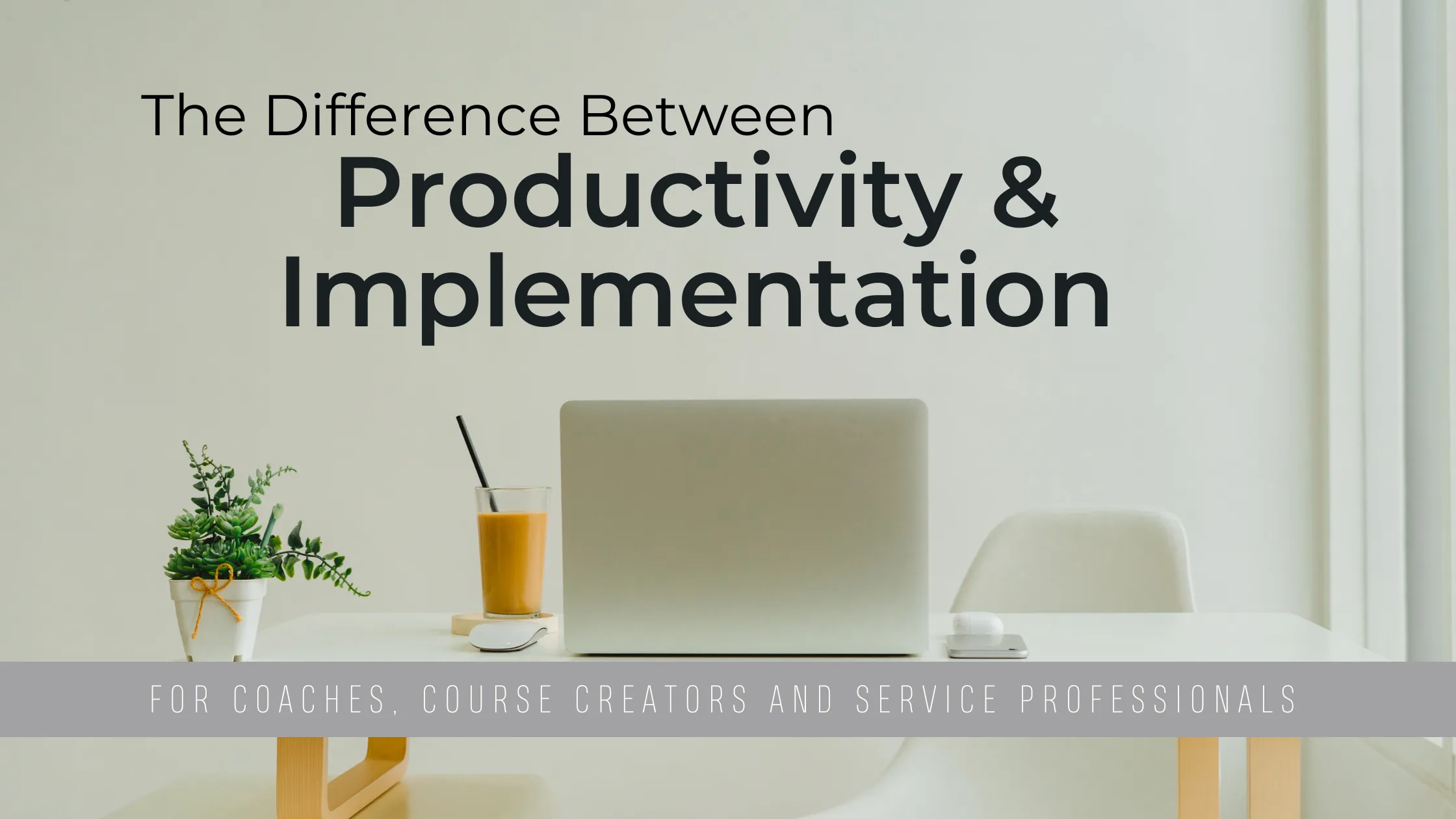Optimize your time management for efficient implementation
If you sit in front of your computer not knowing what to do, or worst, you work hard all day long and find at the end of the day, you accomplished nothing, you could be having an implementation problem.
Often described as a time management problem, implementation problems are a great imposter making you feel frustrated, overwhelmed, and plain stressed-out! Let’s take a look at the difference between time management and implementation so you can be sure you are fixing the right pain point in your business.
Time Management Defined
The Cambridge English Dictionary defines Time Management as the practice of using the time that you have available in a useful and effective way, especially in your work.
Let’s check off the main points here. Are you
- allocating sufficient time to work on your business?
- using that time in a useful and effective way?
If you are weak on allocating time, it might be time to consider looking further into how you allocate time and how you can improve that. Click below to learn more about how to leverage your behavior patterns to determine a working schedule that compliments your life and your business.

If you are weak in using your time effectively, this is a time to look at why that is happening.
Could it be that you:
- don’t have clear direction on what you need to do?
- use distractions as a means of avoiding a difficult or boring task?
- don’t have an understanding of the big picture and what you are working toward?
Implementation Defined
Going back to the Cambridge English dictionary, it defines implementation as the act of putting a plan into action.
Notice the word “plan?”
Now think about the last time you worked on your business and felt frustrated, didn’t know what you were doing, or you were just doing random “things” with no rhyme or reason. It could be that you dove right into the work before you knew what that work was. To do work, one must have a task to do. So how do you determine what tasks you need to do?
At THE SCRUM SHOP©, we are a practicing Scrum shop and as such do our work in small chunks that together create the whole. This approach keeps us from being overwhelmed by all the things needed to build and grow a business.
Working Scrum is like being a bricklayer. While you take care in placing individual bricks, you must also keep the big picture in sight so you create the desired result. It’s the same with your business. There are many things to do as an entrepreneur and building out your business can be overwhelming. But taking a top-down approach can help you drill down to the things you need for each piece. Then you focus your time and effort on just one piece at a time.
Let’s take a look at our top-down approach for better implementation.
Start with the Big Picture
Building a business is hard work. But if you don’t have a high-level plan for your business, you may be spinning your wheels, jumping from one thing to another, or throwing spaghetti at the wall.
Creating a high-level plan, even if it is just on your whiteboard, can help you to identify what parts you need to put together in the foundation of your business. Once those parts are in place, you can begin the continuous improvement process, using data to make adjustments and tweaks along the way. But the big picture is just the first step.
The next step is to look at all the large parts you need and then focus on one of them.
Each part of your business could be an entire project within itself. Understanding what is required to create each part of your business foundation is key to helping you get to the next lower level of your work. But you’re not at the task level yet and jumping right into work at this level may leave you confused, overwhelmed, and unable to complete the project.
Instead, while focusing on just one part of your overall business build-out, identify the pieces that need to be in place to call this part complete.
We call these “parts” projects or sub-projects within the larger project.
Identify the pieces of the project
Now that you know what part you are focusing on, start brainstorming what you need to create it. This still could be at a higher level than you need to be to begin your work with complete clarity. But it is the next step in this top-down approach to determining what you need to do to get the project done.
Now that you have identified what pieces belong in the part of your business foundation you are working on, dig deeper by looking at each piece and begin writing a list of tasks needed to complete the one part.
For example, if you are creating a lead magnet, consider the list of pieces that need to be in place to deliver that lead magnet to your customer. Creating the lead magnet, a small project in itself is only one piece of the entire project of creating a lead magnet.
There are other things to consider like a sales/opt-in page, a thank you page, and an email to confirm and deliver the lead magnet. And don’t forget about the social posts to promote your new lead magnet.
You can see several pieces need to be in place to successfully launch a new lead magnet.
List those pieces out and then you’ll be ready to identify the tasks needed for each piece.
Identify Tasks
Well, at this point you might be ready to simply dive in and start working. However, if “create a lead magnet” feels comfortable for you, and you know exactly what you need to do, then you might be right. But if you are unsure of what to do, start brainstorming the actual tasks that need to be done.
Things might pop up like, needing to decide on which email marketing software to use, or determine what software to use for your opt-in page. Those are just the technical side of things.
You also need to do things like, write copy, design the look and feel of your lead magnet, create images, and so on. When you break down each of the pieces, into tasks, you may find there are quite a few tasks that need to be completed. You might be thinking, “ah, that is where my time is going!”
And you’re right.
That lead magnet seemed pretty innocent but when you dive into it, there is quite a lot to do that you may not have planned for. This can leave you feeling like you have bad time management skills when it was poor planning that sucked all your time. You were unaware of the amount of time it would take because the work was not broken down into individual tasks.
Work Breakdown for Better Outcomes
Breaking down your work into individual tasks has many benefits, including
- knowing in detail what must be done
- easily estimate how long a project or part of a will take
- ability to plan accordingly; no surprises
Taking the time to break your work down into projects, sub-projects and tasks is a great way to ease the stress and overwhelm of building your online business.
Give it a try and remember, Scrum is all about progress, not perfection. So do your best at breaking things down. If you miss something, simply add it in so you can use this as a lesson learned for the next project.






